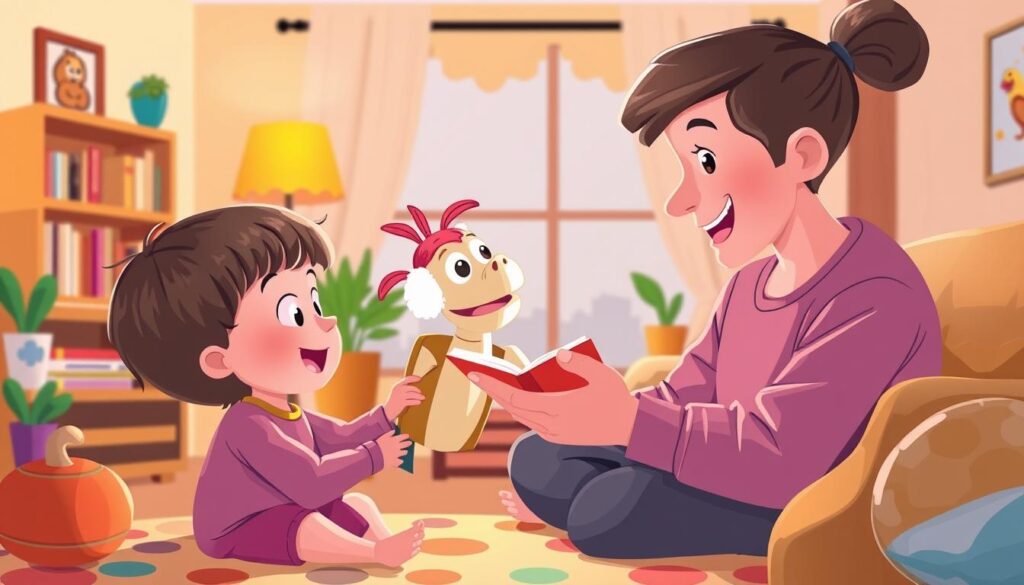Are you tired of reading to your child only to see their eyes glaze over? What if you could transform reading time into a magical experience that sparks their imagination and fosters a lifelong love of story?
I’ve discovered that by incorporating interactive elements into our reading routine, we can create a more meaningful connection and significantly enhance their language development and critical thinking skills.
As a parent and educator, I’m excited to share my favorite techniques that have made our family reading time extraordinary. By bringing stories to life, you can turn your child into an active participant, rather than just a passive listener.
The Magic of Interactive Storytelling for Children
Interactive storytelling has the power to transform the way children engage with stories. By making the experience more immersive and dynamic, we can significantly enhance their development and create a lifelong love for reading.
Benefits of Interactive Reading for Child Development
Interactive storytelling offers numerous benefits for child development. It enhances language skills, fosters creativity, and promotes social awareness. By engaging children actively in the story, we can improve their emotional intelligence and critical thinking abilities.
| Benefits | Description |
|---|---|
| Language Skills | Improves vocabulary and comprehension |
| Creativity | Fosters imagination and creative thinking |
| Social Awareness | Enhances understanding of social cues and relationships |
Transforming Passive Listeners into Active Participants
One of the key aspects of interactive storytelling is its ability to transform children from passive listeners into active participants. By encouraging them to engage with the story through questions, predictions, and discussions, we can make the experience more enjoyable and effective. For more insights on storytelling in early childhood education, you can explore additional resources.
This active participation not only enhances their understanding of the story but also develops their critical thinking and problem-solving skills. As a result, children become more invested in the storytelling process, leading to a more meaningful and lasting experience.
Voice Modulation: Bringing Characters to Life
Bringing characters to life through voice modulation can transform a simple bedtime story into an immersive experience. When you modulate your voice, you create a more engaging and interactive storytelling environment for your child.
Using Different Tones and Accents for Characters
Using different tones and accents for various characters can make your story more engaging. For instance, a gruff tone for a villain and a soft tone for a hero can help your child differentiate between characters.
Adjusting Pace and Volume for Dramatic Effect
Adjusting your reading pace and volume can create a dramatic effect and convey the mood of the story. Slowing down during suspenseful moments builds anticipation, while speeding up during action sequences creates excitement.
Practical Tips for Voice Variation
To effectively modulate your voice, try using different accents, pitches, and volumes for various characters. Consistency is key; maintain the same voice for a character throughout the story. For more tips on effective storytelling, you can visit this resource.
| Technique | Description | Effect on Storytelling |
|---|---|---|
| Different Tones | Using various tones for different characters | Makes characters distinct and engaging |
| Pace Adjustment | Adjusting reading pace for suspense or action | Creates emotional responses and builds anticipation |
| Volume Control | Varying volume for emphasis or whispering | Adds drama and keeps the child engaged |
Incorporating Props and Visual Aids

Props and visual aids are not just accessories; they’re essential tools that make storytelling a multi-sensory experience. By incorporating these elements, you can captivate your child’s imagination and make the story more engaging.
Using Puppets to Enhance Character Engagement
Puppets are magical companions that instantly capture children’s attention. Even a simple sock puppet can transform into a beloved character that your child will want to interact with again and again. By using puppets, you can bring the story to life and make it more relatable for your child.
DIY Props for Different Story Themes
Creating DIY props is a fun and affordable way to enrich storytelling. For adventure stories, you can make a simple treasure map or a pirate hat from cardboard tubes. These props help children feel like they’re part of the thrilling journey, stimulating their imagination and enhancing their engagement.
How Visual Elements Stimulate Imagination
Visual aids help children who are visual learners to better process and remember the story. By providing a concrete starting point, props stimulate imagination and encourage children to build their mental imagery. This is especially helpful for younger children still developing their visualization skills.
By incorporating props and visual aids into your storytelling, you can create a more immersive experience for your child. This approach not only enhances their engagement but also fosters a deeper connection with the story, making storytelling a more enjoyable and memorable experience.
Adding Music and Sound Effects to Stories

Incorporating music and sound effects into storytelling is a powerful way to engage children’s auditory senses and deepen their emotional connection to the narrative. I’ve seen firsthand how the right background music can transport us to fantastical worlds, making the story more immersive and memorable.
Setting the Mood with Background Music
Background music sets the emotional tone for the story, helping children understand the context of different scenes. For instance, gentle lullabies are perfect for bedtime stories, while upbeat tunes can make adventure stories more thrilling. I use simple instruments like a small drum or a rain stick to create an instant atmosphere that complements the narrative.
Creating Immersive Experiences with Sound Effects
Sound effects bring specific story elements to life, creating a multi-sensory experience that makes the story feel real and immediate. Simple actions like rustling paper for leaves or tapping fingers for raindrops can captivate children’s imagination and make the story more engaging.
Matching Music to Different Story Types
Different story types require different types of music. For adventure stories, fast and bold tunes can enhance the excitement, while simple melodies can underscore the ups and downs of a character’s journey. By matching the music to the story type, parents can create a more engaging and immersive experience for their children.
Interactive Storytelling Techniques Child Responds To: Role-Playing
I’ve found that role-playing is one of the most engaging interactive storytelling techniques for children, making storytime both fun and educational. By assigning character roles, creating interactive storylines, and encouraging group involvement, parents can foster a deeper connection between their child and the story.
Character Assignment and Costume Ideas
Assigning character roles to children not only gives them a sense of ownership but also helps them immerse in the narrative. Simple props like a paper crown for a prince or princess, or a blanket cape for a superhero, can significantly enhance their engagement. These props help children step into their characters and become part of the story.
Creating Interactive Storylines with Pauses
Creating interactive storylines involves pausing at key moments and asking children what they think the character should do next. This technique empowers children to become co-creators of the story, making decisions that influence its direction. It’s a powerful way to keep them engaged and invested in the narrative.
Group Involvement Strategies
When reading with multiple children, assigning different characters to each child can create a collaborative storytelling experience. This approach teaches turn-taking and listening skills while keeping everyone involved. For younger children, simple movement-based role-play, such as hopping like a bunny or roaring like a lion, can be particularly effective.
| Role-Playing Benefits | Description |
|---|---|
| Enhances Engagement | Makes storytime more interactive and fun |
| Develops Empathy | Helps children consider situations from different perspectives |
| Fosters Creativity | Encourages children to think creatively and make decisions |

The Art of Asking Engaging Questions
Engaging children with thoughtful questions during storytelling can spark their imagination and curiosity. I’ve discovered that the right question at the right moment can instantly pull my child deeper into the story and spark meaningful conversations that extend far beyond our reading time.
Sparking Imagination with Open-Ended Questions
Open-ended questions invite children to use their imagination and critical thinking skills. Examples include “What do you think might happen next?” or “How do you think the character is feeling right now?” These questions encourage children to think creatively rather than simply absorbing information.
Building Anticipation with Predictive Questions
Predictive questions build anticipation and teach cause-and-effect thinking. Pausing before a plot twist to ask “What do you think will happen when they open the mysterious door?” creates suspense while encouraging your child to analyze story clues.
Learning Life Lessons through Reflective Questions
Reflective questions help children connect stories to their own lives and extract meaningful life lessons. After reading, asking questions like “When have you felt like this character?” or “What would you have done differently?” helps your child process the story’s deeper messages. For more on how stories can aid in language growth, visit Lunesia’s Language Growth Through Stories.
Incorporating Movement and Physical Activity
The art of storytelling can be elevated by incorporating simple movements, making the experience more enjoyable and interactive for children. As we weave physical activity into our storytime, we not only capture their attention but also enhance their understanding and retention of the story.
Simple Yoga Poses That Match Story Themes
Yoga can be a wonderful addition to storytime, promoting both physical health and cognitive development. For example, when reading stories set in forests, children can practice the “Tree Pose,” standing on one leg and balancing. This pose symbolizes strength and stability, much like the trees in the story. For tales of adventure and bravery, the “Warrior Pose” can be empowering, with children standing tall, legs apart, and arms stretched wide.
Action Movements for Adventure Stories
Action movements can bring stories to life, especially for adventure tales. Children can stomp like giants, tiptoe like mice, or swim like fish, physically experiencing the narrative. This not only burns off excess energy but also helps them internalize the story through muscle memory.

Benefits of Physical Engagement During Reading
Incorporating movement during storytelling has numerous benefits. It creates a multi-sensory experience, engaging children on verbal, visual, and kinesthetic levels. This approach is particularly beneficial for kinesthetic learners who process information best through physical activity. Moreover, movement helps regulate energy levels, calming or invigorating children as needed, and creates natural pauses in the narrative for better comprehension.
By combining storytelling with physical activity, we can create a more engaging, memorable, and enjoyable experience for our children, fostering a deeper love for stories and learning.
Creating Personalized Stories with Your Child
Storytelling becomes even more magical when it’s tailored to your child’s unique experiences and interests. By making your child a part of the story, you can create a deeper connection and make the experience more enjoyable.
Including Your Child as the Main Character
When your child is the main character in a story, it validates their importance and builds their self-confidence. For instance, you can create a story where your child overcomes challenges or helps others, reinforcing positive self-image and emotional resilience.
Incorporating Familiar Settings and Experiences
Using familiar settings and experiences in your stories grounds the narrative in your child’s reality while still allowing for imaginative elements. For example, a magical adventure that begins in their bedroom or features their favorite park creates a perfect blend of the familiar and the fantastic.
Collaborative Storytelling Techniques
Collaborative storytelling, where you and your child take turns adding elements to the narrative, develops creativity, listening skills, and respect for others’ ideas. You can start with “Once upon a time there was a child named [your child’s name]” and then alternate adding to the story, fostering a fun and interactive experience.
Conclusion: Nurturing a Lifelong Love for Reading Through Interactive Storytelling
As we wrap up our journey through the world of interactive storytelling, it’s clear that this approach has the power to transform reading into a truly immersive experience for children. By incorporating techniques like voice modulation, props, music, role-playing, and personalized stories, you can create a rich narrative that captivates your child’s imagination and fosters a lifelong love for reading.
These techniques not only enhance your child’s linguistic and cognitive abilities but also promote emotional intelligence, creativity, and communication skills. The beauty of interactive storytelling lies in its flexibility, allowing you to start with simple approaches and gradually incorporate more complex elements as your child grows.
For more interactive stories and learning resources, you can explore interactive stories for learning that can further enrich your storytelling experience. By investing in interactive storytelling, you’re not just creating memorable moments – you’re building a strong foundation for your child’s future success. As you continue on this journey, remember to have fun and be creative – your child will cherish the time spent together, and the stories you share will become a lasting part of their childhood.
FAQ
How can I make reading a fun experience for my child?
You can make reading fun by bringing the story to life with different voices, props, and music. This helps to capture their imagination and keeps them engaged.
What are some ways to encourage my child to participate during reading?
You can encourage participation by asking open-ended questions, assigning roles to your child, and incorporating movement into the story. This helps to build their confidence and makes the experience more enjoyable.
How can I help my child develop their imagination through reading?
You can help develop their imagination by using visual aids, creating immersive experiences with sound effects, and encouraging them to predict what might happen next in the story.
Can I use everyday objects as props during reading?
Yes, you can use everyday objects as DIY props to enhance the story and make it more relatable to your child’s life.
How can I make the story more relatable to my child’s life?
You can make the story more relatable by incorporating familiar settings and experiences, and by making your child the main character in the story.
What are some benefits of using role-playing during reading?
Role-playing helps to build your child’s confidence, encourages active participation, and develops their social skills.
How can I use music and sound effects to enhance the story?
You can use background music to set the mood, and sound effects to create a more immersive experience. This helps to capture your child’s imagination and keeps them engaged.




